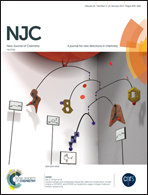A comparative study of the electrochemical and the spectroscopic behaviour of trisbipyrazyl ruthenium [Ru(bpz)32+]
Abstract
A comparative study of the ultraviolet-visible spectrum and of the electrochemical behavior of the [Ru(bpz)32+] ion has been made. An examination of the recorded UV spectrum allows us to determine the wavelengths at which different electronic transitions take place. The energies at which these transitions take place correspond to the energy differences between the molecular orbitals in the ruthenium complex which are involved in the electronic transitions observed. With these data, and the wavelength of the maximum of the emission spectrum also recorded, drawing of the Jablonski diagram for the [Ru(bpz)32+] ion is possible. By comparing the energy differences between the molecular levels identified in the Jablonski diagram with the differences in potential values at which the various redox processes recorded in the cyclic voltammogram take place, it is possible to identify the electronic levels in the ruthenium complex which are involved in the redox reactions responsible for the cyclic voltammetric waves registered in the electrochemical study. The close correlation found between the spectroscopic and the electrochemical results confirms the first definition given for the cyclic voltammetry as electrochemical spectroscopy and allows the undoubted identification of the molecular orbitals that are involved in the different charge transfer reactions with the electrode.
![Graphical abstract: A comparative study of the electrochemical and the spectroscopic behaviour of trisbipyrazyl ruthenium [Ru(bpz)32+]](/en/Image/Get?imageInfo.ImageType=GA&imageInfo.ImageIdentifier.ManuscriptID=C6NJ03266D&imageInfo.ImageIdentifier.Year=2017)


 Please wait while we load your content...
Please wait while we load your content...